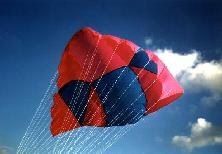 or bigger.
or bigger. or bigger.
or bigger.
Copyright 1995, 1996 Buck Childers
(Note: At Mel Jongen's site there is a Dutch version of this plan. Joep, Thuur & Mel have some done some nice work with the drawings to make them easier to read and details of the construction easier to understand. Even if you don't speak Dutch it may be helpful to take a look.)
The above link does not work. Try this temperary one until a new Dutch link is found.
This kite is based on 1960's experimentation that NASA conducted on Francis Rogallo's parachute designs. NASA experimented with ten variations of the same basic delta shape changing the relative angle of the two keels with each model. The fifth, model 5, evidently showed the most promise for controllability and stability. The keels are formed from the row of bridle leg connections in the midsection of the sail. Some of the classic kite books that cover Rogallo show a photo of wind tunnel test being performed on model 5. I have always been intrigued by the form.
In 1995 Chuck VanEekelen, a kite flyer in the Netherlands, sent me a Dutch plan, containing basic dimensions and bridling information, necessary to turn Model 5 into a controllable kite. Chuck and I worked through our first couple of these together shared construction tips and improvement suggestions via e-mail along the way. The following plan is my representation of the kite and how to build it.
---Added May 1996---
In April 1996 I ran across Mel Jongen's www page that had a Dutch version of this plan. As
it turns out Mel was the person that provided Chuck with the plan just before Chuck and I
got together. Mel's version is available at his site. His bridle measurements
for A11, A12, and B6 had been optimized and I've included those changes in my tables.
(Thanks Mel)
---
Model 5 is a single skinned, sparless, parawing. It is meant for traction, (ie. It Pulls!). Mine is usually dual line although it can easily be set up for quad. It turns quick but it's forward speed is relatively slow. It has a moderately narrow power zone. I've buggied with it but it really doesn't have edge characteristics that make a useable buggy engine. Darts are sewn in the nose area to create a significant camber which is maintained through air pressure and the bridle structure. The standard version has a sail area of 3m^2 (about 30sq ft). The kite can easily be scaled from .7m^2, which makes a nice toy, to over 7m^2 which could be quite dangerous. Even in the 3m^2 version it has a tendency not to want to land.
All measurements needed are calculated based on the keel length you pick as a starting point. If you like inches use inches if you like cm. use cm. I prefer metric so the example given is based on a 2 meter keel length providing a sail area of 3 meters (about 30 ft^2).
The drawings show threee main panels; one center and two wing panels. Add your favorite
seam and hem allowance where appropriate. I prefer to use a 1cm French seam where the wing
panels attach to the center panel and creating a 1cm hem by folding a 2cm strip around the
edge and sewing it on. This creates a tunnel to thread the dacron line for reinforcement.
Add reinforcements AFTER the sail is seamed, darted and hemmed. You should have marked
bridle attachment points and seven (7) tie down points prior to darting nose.
Affix the line by sewing through it along the length of the seam.
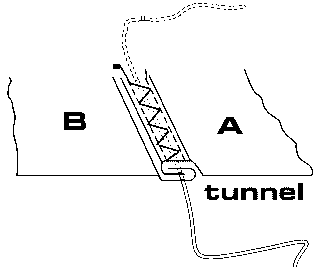

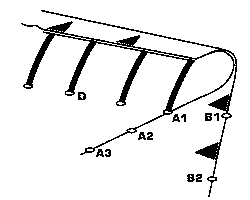
The bridle lengths are provided in the table below. I use the following technique to
attach bridle legs. It allows me to remove the entire bridle or make adjustments to
individual bridle legs with relative ease.
Bring together all the bridle legs on the left side to a single tow
point
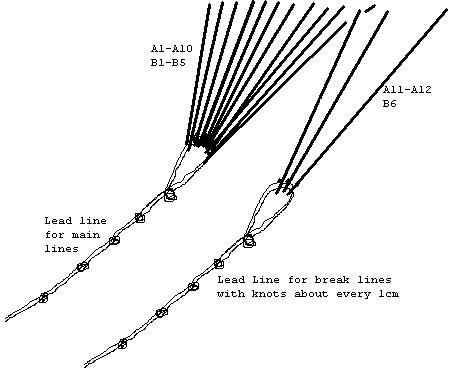
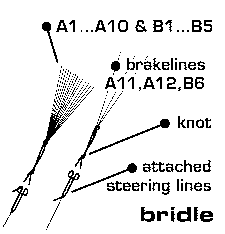
Each individual bridle leg is adjustable. Every change has an affect on the
characteristics of the sail and a little experimentation will allow you to maximize
performance. When tuned the kite should have good forward movement without
"lurching". Lurching usually indicates that the sail is too flat, lengthen lines
in the A3-A4 area. Changing the tie lines that keep the nose shape will also change the
flight characteristics.
In dual line flight the most common adjustments are for different wind speeds. In lower winds A11, A12, and B6 by a few centimeters. In higher wind lengthen them. This process is simplified by bringing together these lines to their own towpoint and making the adjustment at the towpoint..
Quading is accomplished by bringing together bridle legs A11, A12, and B6 together in a
single towpoint and using this as the break line. In quad line flight you basically have
the ability to make the dual line adjustments variable.
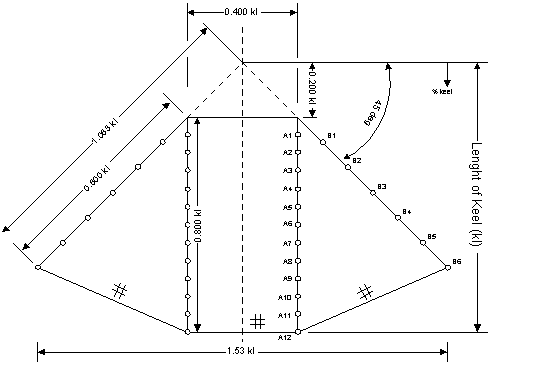
Bridle |
Factor |
Length for kl=2 (cm) |
A1 |
0.975 |
195.0 |
A2 |
0.990 |
198.0 |
A3 |
0.985 |
197.0 |
A4 |
0.975 |
195.0 |
A5 |
0.980 |
196.0 |
A6 |
0.975 |
195.0 |
A7 |
0.985 |
197.0 |
A8 |
0.970 |
194.0 |
A9 |
0.960 |
192.0 |
A10 |
0.955 |
191.0 |
A11 |
0.925 |
185.0 |
A12 |
0.870 |
174.0 |
B1 |
0.930 |
186.0 |
B2 |
0.910 |
182.0 |
B3 |
0.875 |
175.0 |
B4 |
0.850 |
170.0 |
B5 |
0.775 |
155.0 |
B6 |
0.700 |
140.0 |
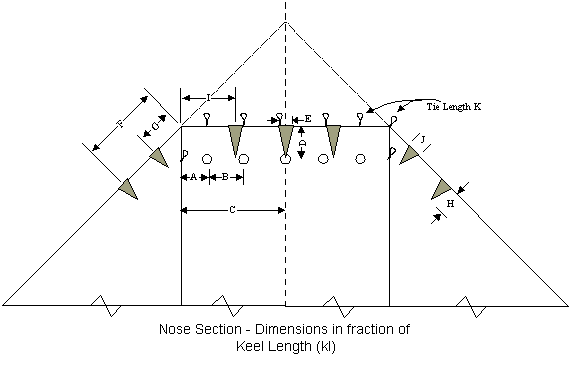
Measure |
Factor |
Length for kl=2 (cm) |
A |
0.054 |
10.8 |
B |
0.063 |
12.6 |
C |
0.200 |
40.0 |
D |
0.066 |
13.2 |
E |
0.017 |
3.4 |
F |
0.080 |
16.0 |
G |
0.040 |
8.0 |
H |
0.026 |
5.2 |
I |
0.096 |
19.2 |
J |
0.020 |
4.0 |
K |
0.026 |
5.2 |
If you build from these plans please let me know. I would like to hear from people about experiences with the kite and suggestions for improvement to the plans.
Buck Childers mailto:buckchil@sound.net
P E A C E